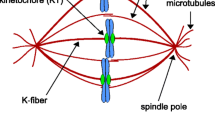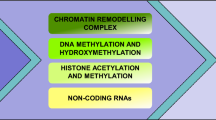Abstract
Organisms alter gene expression to adapt to changes in environmental conditions such as temperature, nutrients, inflammatory signals, and stress (Gialitakis et al. in Mol Cell Biol 30:2046–2056, 2010; Conrath in Trends Plant Sci 16:524–531, 2011; Avramova in Plant J 83:149–159, 2015; Solé et al. in Curr Genet 61:299–308, 2015; Ho and Gasch in Curr Genet 61:503–511, 2015; Bevington et al. in EMBO J 35:515–535, 2016; Hilker et al. in Biol Rev Camb Philos Soc 91:1118–1133, 2016). In some cases, organisms can “remember” a previous environmental condition and adapt to that condition more rapidly in the future (Gems and Partridge 2008). Epigenetic transcriptional memory in response to a previous stimulus can produce heritable changes in the response of an organism to the same stimulus, quantitatively or qualitatively altering changes in gene expression (Brickner et al. in PLoS Biol, 5:e81, 2007; Light et al. in Mol Cell 40:112–125, 2010; in PLoS Biol, 11:e1001524, 2013; D’Urso and Brickner in Trends Genet 30:230–236, 2014; Avramova in Plant J 83:149–159, 2015; D’Urso et al. in Elife. doi: 10.7554/eLife.16691, 2016). The role of chromatin changes in controlling binding of poised RNAPII during memory is conserved from yeast to humans. Here, we discuss epigenetic transcriptional memory in different systems and our current understanding of its molecular basis. Our recent work with a well-characterized model for transcriptional memory demonstrated that memory is initiated by binding of a transcription factor, leading to essential changes in chromatin structure and allowing binding of a poised form of RNA polymerase II to promote the rate of future reactivation (D’Urso et al. in Elife. doi: 10.7554/eLife.16691, 2016).

Similar content being viewed by others
References
Ardehali MB, Mei A, Zobeck KL et al (2011) Drosophila Set1 is the major histone H3 lysine 4 trimethyltransferase with role in transcription. EMBO J 30:2817–2828. doi:10.1038/emboj.2011.194
Avramova Z (2015) Transcriptional “memory” of a stress: transient chromatin and memory (epigenetic) marks at stress-response genes. Plant J 83:149–159. doi:10.1111/tpj.12832
Berry DB, Gasch AP (2008) Stress-activated genomic expression changes serve a preparative role for impending stress in yeast. Mol Biol Cell 19:4580–4587. doi:10.1091/mbc.E07-07-0680
Bevington SL, Cauchy P, Piper J et al (2016) Inducible chromatin priming is associated with the establishment of immunological memory in T cells. EMBO J 35:515–535. doi:10.15252/embj.201592534
Brickner DG, Cajigas I, Fondufe-Mittendorf Y et al (2007) H2A.Z-Mediated localization of genes at the nuclear periphery confers epigenetic memory of previous transcriptional state. PLoS Biol 5:e81. doi:10.1371/journal.pbio.0050081.st001
Briggs SD, Bryk M, Strahl BD et al (2001) Histone H3 lysine 4 methylation is mediated by Set1 and required for cell growth and rDNA silencing in Saccharomyces cerevisiae. Genes Dev 15:3286–3295
Capelson M, Liang Y, Schulte R et al (2010) Chromatin-bound nuclear pore components regulate gene expression in higher eukaryotes. Cell 140:372–383. doi:10.1016/j.cell.2009.12.054
Conrath U (2011) Molecular aspects of defence priming. Trends Plant Sci 16:524–531. doi:10.1016/j.tplants.2011.06.004
Ding Y, Fromm M, Avramova Z (2012) Multiple exposures to drought “train” transcriptional responses in Arabidopsis. Nat Commun 3:740. doi:10.1038/ncomms1732
Ding Y, Liu N, Virlouvet L et al (2013) Four distinct types of dehydration stress memory genes in Arabidopsis thaliana. BMC Plant Biol 13:229. doi:10.1186/1471-2229-13-229
D’Urso A, Brickner JH (2014) Mechanisms of epigenetic memory. Trends Genet 30:230–236. doi:10.1016/j.tig.2014.04.004
D’Urso A, Takahashi YH, Xiong B et al (2016) Set1/COMPASS and Mediator are repurposed to promote epigenetic transcriptional memory. Elife. doi:10.7554/eLife.16691
Fujita A, Kikuchi Y, Kuhara S et al (1989) Domains of the SFL1 protein of yeasts are homologous to Myc oncoproteins or yeast heat–shock transcription factor. Gene 85:321–328
Gasch AP, Spellman PT, Kao CM et al (2000) Genomic expression programs in the response of yeast cells to environmental changes. Mol Biol Cell 11:4241–4257
Gems D, Partridge L (2008) Stress-response hormesis and aging: “that which does not kill us makes us stronger”. Cell Metab 7(3):200–203. doi:10.1016/j.cmet.2008.01.001
Gialitakis M, Arampatzi P, Makatounakis T, Papamatheakis J (2010) Gamma interferon-dependent transcriptional memory via relocalization of a gene locus to PML nuclear bodies. Mol Cell Biol 30:2046–2056. doi:10.1128/MCB.00906-09
Guan Q, Haroon S, Bravo DG et al (2012) Cellular memory of acquired stress resistance in Saccharomyces cerevisiae. Genetics 192:495–505. doi:10.1534/genetics.112.143016
Hilker M, Schwachtje J, Baier M et al (2016) Priming and memory of stress responses in organisms lacking a nervous system. Biol Rev Camb Philos Soc 91:1118–1133. doi:10.1111/brv.12215
Ho Y-H, Gasch AP (2015) Exploiting the yeast stress-activated signaling network to inform on stress biology and disease signaling. Curr Genet 61:503–511. doi:10.1007/s00294-015-0491-0
Hughes CM, Rozenblatt-Rosen O, Milne TA et al (2004) Menin associates with a trithorax family histone methyltransferase complex and with the hoxc8 locus. Mol Cell 13:587–597
Jeronimo C, Robert F (2014) Kin28 regulates the transient association of Mediator with core promoters. Nat Struct Mol Biol 21:449–455. doi:10.1038/nsmb.2810
Kim T, Buratowski S (2009) Dimethylation of H3K4 by Set1 recruits the Set3 histone deacetylase complex to 5′ transcribed regions. Cell 137:259–272. doi:10.1016/j.cell.2009.02.045
Kim T, Xu Z, Clauder-Münster S et al (2012) Set3 HDAC mediates effects of overlapping noncoding transcription on gene induction kinetics. Cell 150:1158–1169. doi:10.1016/j.cell.2012.08.016
Krogan NJ, Dover J, Khorrami S et al (2002) COMPASS, a histone H3 (Lysine 4) methyltransferase required for telomeric silencing of gene expression. J Biol Chem 277:10753–10755
Kundu S, Horn PJ, Peterson CL (2007) SWI/SNF is required for transcriptional memory at the yeast GAL gene cluster. Genes Dev 21:997–1004
Lämke J, Brzezinka K, Altmann S, Baurle I (2016) A hit-and-run heat shock factor governs sustained histone methylation and transcriptional stress memory. EMBO J 35:162–175. doi:10.15252/embj.201592593
Lee J-H, Tate CM, You J-S, Skalnik DG (2007) Identification and characterization of the human Set1B histone H3-Lys(4) methyltransferase complex. J Biol Chem 282:13419–13428. doi:10.1074/jbc.M609809200
Light WH, Brickner DG, Brand VR, Brickner JH (2010) Interaction of a DNA zip code with the nuclear pore complex promotes H2A.Z incorporation and nbsp; INO1 transcriptional memory. Mol Cell 40:112–125. doi:10.1016/j.molcel.2010.09.007
Light WH, Freaney J, Sood V et al (2013) A conserved role for human Nup98 in altering chromatin structure and promoting epigenetic transcriptional memory. PLoS Biol 11:e1001524. doi:10.1371/journal.pbio.1001524
Liu N, Ding Y, Fromm M, Avramova Z (2014) Different gene-specific mechanisms determine the “revised-response” memory transcription patterns of a subset of A. thaliana dehydration stress responding genes. Nucl Acids Res 42:5556–5566. doi:10.1093/nar/gku220
Maxwell CS, Kruesi WS, Core LJ et al (2014) Pol II docking and pausing at growth and stress genes in C. elegans. Cell Rep 6:455–466. doi:10.1016/j.celrep.2014.01.008
Mohan M, Herz H-M, Smith ER et al (2011) The COMPASS family of H3K4 methylases in Drosophila. Mol Cell Biol 31:4310–4318. doi:10.1128/MCB.06092-11
Pavri R, Lewis B, Kim T-K et al (2005) PARP-1 determines specificity in a retinoid signaling pathway via direct modulation of mediator. Mol Cell 18:83–96. doi:10.1016/j.molcel.2005.02.034
Petruk S, Sedkov Y, Smith S et al (2001) Trithorax and dCBP acting in a complex to maintain expression of a homeotic gene. Science 294:1331–1334. doi:10.1126/science.1065683
Pigliucci M (2005) Evolution of phenotypic plasticity: where are we going now? Trends Ecol Evol (Amst) 20:481–486. doi:10.1016/j.tree.2005.06.001
Ragunathan K, Jih G, Moazed D (2015) Epigenetic inheritance uncoupled from sequence-specific recruitment. Science 348:1258699. doi:10.1126/science.1258699
Robertson LS, Fink GR (1998) The three yeast A kinases have specific signaling functions in pseudohyphal growth. Proc Natl Acad Sci USA 95:13783–13787
Roguev A, Schaft D, Shevchenko A et al (2001) The Saccharomyces cerevisiae Set1 complex includes an Ash2 homologue and methylates histone 3 lysine 4. EMBO J 20:7137–7148. doi:10.1093/emboj/20.24.7137
Sani E, Herzyk P, Perrella G et al (2013) Hyperosmotic priming of Arabidopsis seedlings establishes a long-term somatic memory accompanied by specific changes of the epigenome. Genome Biol 14:R59. doi:10.1186/gb-2013-14-6-r59
Santos-Rosa H, Schneider R, Bannister AJ et al (2002) Active genes are tri-methylated at K4 of histone H3. Nature 419:407–411. doi:10.1038/nature01080
Schaner CE, Deshpande G, Schedl PD, Kelly WG (2003) A conserved chromatin architecture marks and maintains the restricted germ cell lineage in worms and flies. Dev Cell 5:747–757
Shilatifard A (2008) Molecular implementation and physiological roles for histone H3 lysine 4 (H3K4) methylation. Curr Opin Cell Biol 20(3):341–348. doi:10.1016/j.ceb.2008.03.019
Solé C, Nadal-Ribelles M, de Nadal E, Posas F (2015) A novel role for lncRNAs in cell cycle control during stress adaptation. Curr Genet 61:299–308. doi:10.1007/s00294-014-0453-y
Song W, Carlson M (1998) Srb/mediator proteins interact functionally and physically with transcriptional repressor Sfl1. EMBO J 17:5757–5765. doi:10.1093/emboj/17.19.5757
Tan-Wong SM, Wijayatilake HD, Proudfoot NJ (2009) Gene loops function to maintain transcriptional memory through interaction with the nuclear pore complex. Genes Dev 23:2610–2624. doi:10.1101/gad.1823209
Wong KH, Jin Y, Struhl K (2014) TFIIH phosphorylation of the Pol II CTD stimulates mediator dissociation from the preinitiation complex and promoter escape. Mol Cell 54:601–612. doi:10.1016/j.molcel.2014.03.024
Wu M, Wang PF, Lee J-S et al (2008) Molecular regulation of H3K4 trimethylation by Wdr82, a component of human Set1/COMPASS. Mol Cell Biol 28:7337–7344. doi:10.1128/MCB.00976-08
Zacharioudakis I, Gligoris T, Tzamarias D (2007) A yeast catabolic enzyme controls transcriptional memory. Curr Biol 17:2041–2046
Acknowledgements
The authors thank members of the Brickner laboratory for helpful comments on the manuscript and Nate Delage for help with the figures. The authors are supported by NIH R01 GM118712 (JHB) and T32 GM008061 (AD).
Author information
Authors and Affiliations
Corresponding author
Additional information
Communicated by M. Kupiec.
Rights and permissions
About this article
Cite this article
D’Urso, A., Brickner, J.H. Epigenetic transcriptional memory. Curr Genet 63, 435–439 (2017). https://doi.org/10.1007/s00294-016-0661-8
Received:
Revised:
Accepted:
Published:
Issue Date:
DOI: https://doi.org/10.1007/s00294-016-0661-8




